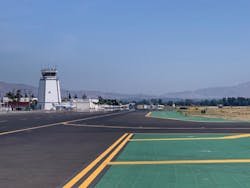Van Nuys Airport Completes $35.5 Million, 15-Month Taxiway A Rehabilitation Project
Los Angeles World Airports (LAWA) on July 2, announced the successful completion of a $35.5-million, 15-month project to rehabilitate Taxiway A at Van Nuys Airport (VNY). The work expands the taxiway's pavement life by 20 years, enhances safety and meets new Federal Aviation Administration (FAA) design standards.
"Van Nuys Airport continues to demonstrate it is the premier general aviation airport in the country with modern and safe facilities that are among the most emulated by peer airports," said Justin Erbacci, Chief Executive Officer, LAWA. "I want to thank our project team and Van Nuys Airport tenants for working collaboratively to coordinate the design, phasing and construction in a manner that mitigated operational impacts and kept the airport running smoothly."
Rehabilitation of the 8,000-foot taxiway was accomplished in 12 phases and included full-depth asphalt taxiway reconstruction; installation of LED centerline and edge lights; airfield signage and pavement marking upgrades; taxiway geometry enhancements and infield grading and drainage improvements. Ninety percent of the project was federally funded under two Airport Improvement Program grants.
The Taxiway A Rehabilitation Project was managed by LAWA's Airport Development Program staff with HNTB Corporation as the engineer and Granite Construction Company as the general contractor. It is the second of two major projects completed over the past four years to rehabilitate the pavement of Taxiways A and B at VNY.
"The Taxiway A project presented another opportunity for airport businesses to work in partnership with Los Angeles World Airports and the FAA on solutions to limit the number of days in which runways, taxiways and leasehold access points were impacted during construction," said Van Nuys Airport Association President Curt Castagna. "This project ultimately enhances safety for pilots by providing better visual acuity, standardized taxiway nomenclature and improved communication with the air traffic control tower."



